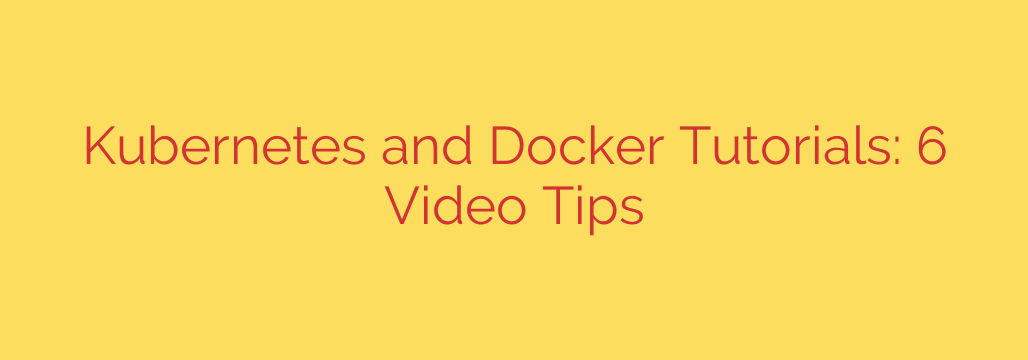
Beyond the Tutorial: 6 Actionable Tips for Mastering Docker and Kubernetes
Learning Docker and Kubernetes has become essential for anyone in modern software development, DevOps, or cloud engineering. These powerful tools for containerization and orchestration are the bedrock of scalable, resilient applications. While video tutorials offer a fantastic entry point, simply watching someone else code is not enough to build true expertise.
To move from a passive learner to a confident practitioner, you need a strategy. The following tips are designed to help you absorb complex concepts, retain critical information, and develop the practical skills needed to excel with Docker and Kubernetes.
1. Move From Passive Watching to Active Doing
It’s easy to watch an expert navigate the command line with speed and precision. However, true learning happens when your own fingers are on the keyboard. The muscle memory and problem-solving skills you gain from hands-on practice are irreplaceable.
The most effective way to internalize commands and concepts is to type them out yourself. When a tutorial shows a docker build command or a kubectl apply command, pause the video and run it in your own terminal. Experiment with the flags, read the output, and see what happens. This active engagement turns abstract knowledge into tangible skill.
2. Understand the “Why,” Not Just the “What”
Copying and pasting a YAML file to deploy a pod is easy. Understanding what each line in that file does is where real mastery begins. Don’t just follow instructions blindly; cultivate a deep curiosity about the underlying mechanics.
Before running a command, ask yourself: What do I expect this to do? What problem does it solve? After running it, use inspection tools to verify the outcome. Commands like docker inspect <container_id> and kubectl describe pod <pod_name> are your best friends. They provide a wealth of information that helps connect the command you ran to the change it made in the system.
3. Deconstruct Complex Topics into Manageable Chunks
Kubernetes, in particular, is a vast ecosystem with many interconnected components. Trying to learn everything at once—networking, storage, scheduling, and security—is a recipe for burnout. The key is to break it down.
Focus on mastering one concept at a time—like Pods or Services—before moving on to the next. Start with Docker fundamentals: building images with a Dockerfile and managing containers. Then, move to Kubernetes, focusing first on core objects like Pods, Deployments, and Services. A structured, incremental approach prevents you from becoming overwhelmed and builds a solid foundation for more advanced topics.
4. Solidify Your Knowledge by Summarizing
One of the best ways to test your understanding of a topic is to try and explain it to someone else. This forces you to organize your thoughts and identify gaps in your knowledge.
After a learning session, write down a simple summary of what you learned in your own words. You don’t have to publish a full blog post. It could be a short document, a note, or even just explaining the concept of a ReplicaSet out loud. If you can articulate it clearly and simply, you truly understand it.
5. Apply Your Skills to a Real-World Project
Tutorials provide a controlled environment, but the real world is messy. The ultimate test of your skills is applying them to a project of your own. This is where you will encounter unique problems and be forced to find your own solutions.
The ultimate test of your understanding is to build a personal project, no matter how small. Take a simple web application you’ve built before and containerize it with Docker. Then, write the Kubernetes manifests to deploy it on a local cluster like Minikube or Kind. This process of building, deploying, and troubleshooting is where the most valuable learning occurs.
6. A Critical Note on Security: Building Good Habits Early
As you learn to build and deploy containers, it’s crucial to integrate security practices from the very beginning. Treating security as an afterthought is a common mistake that can have serious consequences.
- Scan your container images. Use tools like Trivy or Snyk to check your Docker images for known vulnerabilities before deploying them.
- Practice the principle of least privilege. Avoid running containers as the root user. Define clear security contexts and role-based access control (RBAC) policies in Kubernetes.
- Manage secrets properly. Never hardcode passwords, API keys, or other sensitive data directly in your Dockerfiles or YAML manifests. Learn to use Docker Secrets or Kubernetes Secrets to handle them securely.
By incorporating these learning strategies, you will accelerate your journey from beginner to expert. Remember that mastering Docker and Kubernetes is a marathon, not a sprint. Consistent, active, and project-based learning is the most reliable path to success.
Source: https://collabnix.com/6-video-tips-for-kubernetes-and-docker-tutorials/








